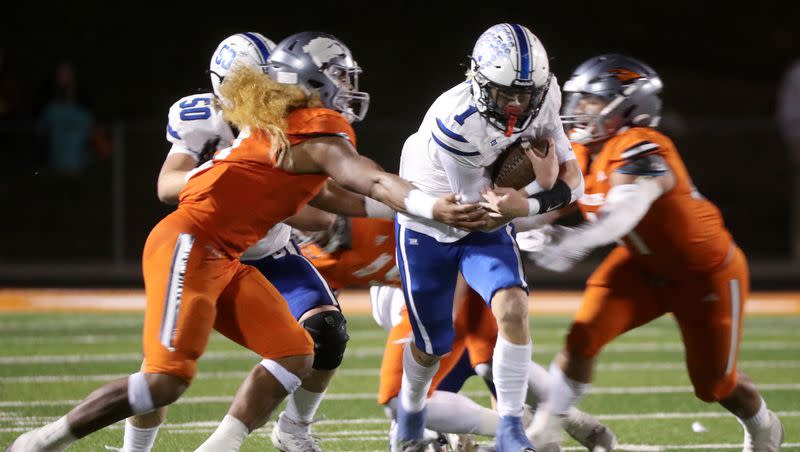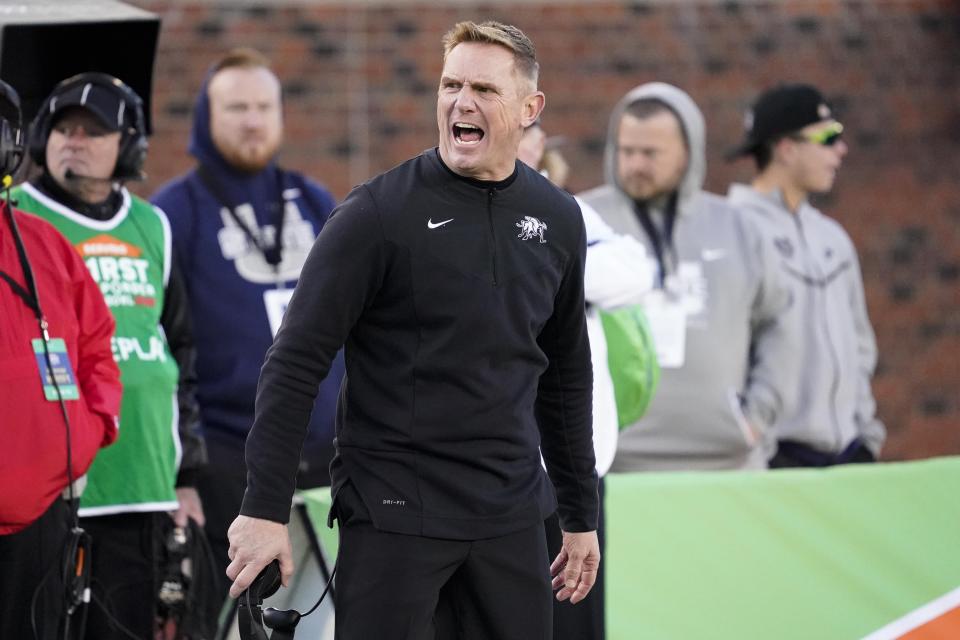Utah State needs to recruit better linemen. Can enough be found in Utah?

“We’ve got to close the gap.”
That has been Blake Anderson’s favorite saying of late.
The Utah State football coach has not been shy about using it either, pulling out the phrase multiple times following the Aggies’ loss to Boise State Saturday night and again on Monday afternoon during his weekly press conference ahead of Friday’s game against New Mexico.
What does he mean by it?
Put simply, Utah State does not have the physicality it needs to compete at the top of the Mountain West Conference, particularly on the offensive and defensive lines.
Aggies on the air
Utah State (5-6, 3-4)
at New Mexico (4-7, 2-5)
Friday, 1:30 p.m. MST
University Stadium
TV: CBS Sports Network
Radio: Aggie Sports Network
That showed pretty clearly in blowout loses to San Jose State and Boise State, both of whom remain in the middle of the conference title race — along with UNLV — while Utah State is battling to become bowl eligible.
“We talked very clearly after the (Boise State) game, and it’s no different today,” Anderson said. “We’ve got to close the gap between us and just how physical they are, how well-built they are, and that’s something that we get to continue to work on in recruiting and development.”
On the development front, Anderson is happy with the progress of the linemen the Aggies do have. Of that he’s been clear many times.
The issue is that they are young and inexperienced, especially along the offensive line, with players like Teague Andersen (10 games played), Tavo Motu’apuaka (seven games), Aloali’i Maui (11 games) and Bryce Radford (11 games) seeing considerable playing time this season.
Multiple underclassmen have been key contributors along the defensive line as well, including Seni Tuiaki (11 games played), Paul Fitzgerald (11 games), Bo Maile (nine games), Enoka Miago (11 games) and Ioholani Raass (six games).
“I think we’re seeing improvement,” Anderson said, “but most of them hadn’t played very much at all (before this year). You’ve got freshmen, redshirt freshmen and true sophomores.”
Even more veteran players — at least as far as class goes — are greatly inexperienced, such as ASU graduate transfer Ralph Frias III.
“Ralph, who is a big body, never really played meaningful snaps at Arizona State at all,” Anderson said. “These guys are learning on the road, and we’re learning by making some mistakes along the way. At times we look really good, and at times we look really bad.
“We haven’t scored the points we’ve scored this season with those guys playing terrible all season long. It’s just that this is a really, really good conference in terms of just how well-built the fronts are, how powerful and twitchy O-lines and D-lines are.
“We’re trying to bridge the gap, so yeah, I think we’re gonna get better,” Anderson continued. “Every time they go out and play they learn more, and (if they have) a great offseason and summer, are able to put on maybe five to 10 pounds of muscle, learn better technique and have a better understanding of what this league looks like, they (can) be effective in it. It’s not a fun process, but you have to have perspective and a little patience, and nobody likes that.”
Still, as Anderson has said repeatedly, the Aggies don’t have everything, or rather everyone, they need up front on the roster. USU needs to recruit more, bigger, stronger and faster linemen.
Many fans will hear that and think, “Great!” After all, the state of Utah has been known for producing some of the best linemen in the country, on both sides of the ball.
Per Anderson, though, getting those talented linemen to Utah State has never been more difficult.
“We’ve been able to get the skill that can run, but we are struggling to build the fronts,” he said. “And we all know the numbers in the state of Utah. We can’t live by Utah kids alone. You’ve got some really good people coming in recruiting. We are struggling head-to-head with a lot of Pac-12 and Power Five programs.
Related
Many notable Aggies questionable for regular-season finale against New Mexico
Utah State must improve its roster and retain existing talent and the Aggies know it
“Now that NIL has been added (to the mix), guys can really effectively expand their rosters and take in even more big guys, so we’ve got to go into Texas, California, Colorado, wherever, in everybody else’s backyards, to recruit those big guys to build our roster.”
Anderson isn’t wrong, both when it comes to getting Utah linemen to go to USU as well as the impact of NIL.
When it comes to the latter, per On3 Sports, starting offensive and defensive linemen have never been more valuable in the transfer market, to the tune of $75,000 to $125,000 annually for a transfer O-lineman and between $200,000 to $300,000 for a starting-caliber edge rusher.
“All those numbers are before an athlete/agent starts pitting schools against each other,” Pete Nakos writes.
Additionally, in-state with high school prospects, Utah State has struggled to reel in top-20-rated linemen during the Anderson era, and for good reason.
Per 247 Sports, the Aggies were beaten out by Utah, UCLA and Washington State for five coveted linemen in 2020, though Raass ended up an Aggie after signing with the Bruins.
The Aggies were beaten out by Oregon, BYU, Washington, Utah, Nebraska, Washington State, Oregon State and Stanford for 10 top in-state linemen in 2021, though USU did add the aforementioned Maile.
In 2022, Utah State missed out on top in-state linemen to Oregon, BYU, Baylor and Utah, and the one the Aggies landed — Weylin Lapuaho — had a standout true freshman season before transferring.
This past signing class, in 2023, things continued the way they have, with Utah, Washington State, Oregon and BYU all beating the Aggies for key in-state linemen, and though the Aggies did sign two highly touted offensive linemen in Taliafi Taala and Jr Sia, only one ended up an Aggie (Sia), and he hasn’t made an appearance in a game this season.
“We’ve got to find a strategy that works,” Anderson said, “and we’ve got to become bigger, more powerful and more physical on both fronts to be able to compete in games.
“That’s the toughest part, I think, of being here in this particular footprint with the numbers available, or even the numbers not available to you in Utah with the way things are now.”


